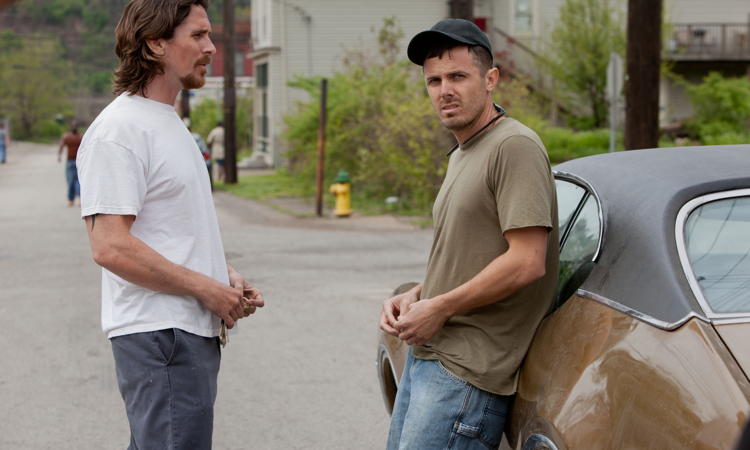By Gary Suderman · December 4, 2013

Out of the Furnace joins 12 Years a Slave and August: Osage County in the rarefied air of this year’s films to claim a wholly remarkable ensemble cast. In his follow-up to Crazy Heart, Scott Cooper recruited Christian Bale, Casey Affleck, Zoë Saldana, Woody Harrelson, Forest Whitaker, Willem Dafoe, and Sam Shepard to play the eclectic residents of Braddock, Pennsylvania and nearby towns of the economically troubled Rust Belt in an engrossing tale of steel workers, soldiers, and sociopaths.
In a recent press conference for the film, Cooper explained his personal connection to the material. While promoting Crazy Heart, he discovered Braddock, once a nexus of steel mill production, now crawling along after an extended thirty-year decline. “What the town [Braddock] had undergone, dealing with economic turmoil and the loss of the steel industry, really touched me.” He took the Black Listed script for The Low Dweller and added elements of the Great Recession. “It was important to me to shine a light, not only on small town America, but also what we as Americans have undergone these last five years.”
A commitment to verisimilitude meant that the production shot entirely on location. As brothers Russell and Rodney Baze, Jr., Bale and Affleck were charged with creating a natural and believable family life. While building his character, a dedicated mill worker who has an unfortunate brush with the law, Bale dug into the ethos of the men who live their entire lives in the town and become the anchor for their communities. Shooting in the actual town turned out to be a crucial distinction. Bale described it as “the difference between performing for the rectangle of the camera versus a world being created, and the camera finds things within that.” He commended Cooper for creating that environment. “You don’t feel like you’re performing. You’re just existing.”
The film includes small details such as the practice of scraping uneaten food into the trash rather than throwing it down the sink. Those quotidian, commonplace moments balance the elevated stakes of sacrifice, death, and pure evil. To realize Rodney, who resorts to gambling and fighting upon returning from his service, Affleck dug into the experiences of veterans after multiple tours of duty, who come home to struggle with Post-Traumatic Stress Disorder and a difficult transition to civilian life. In one of the film’s most touching scenes, Rodney confronts Russell, shouting in frustration, “I gave my life for this country, and what’s it done for me?” Affleck added, “There’s a real story in the way that [Braddock] looks. It has a lot of atmosphere. If there’s a lighting setup that takes twenty minutes, you can go into another room and you’re not just standing, staring at the back of a bunch of plywood; you’re actually in another room in your own house. It helps to ground you.”
Portraying Lena, Rodney’s lover, Saldana had the charge of evoking a dramatic internal transformation in the course of two scenes, spaced years apart. In one of the film’s most striking moments, she and Rodney reunite on a bridge overlooking the town, each overcome by emotion and the pain of years apart. Saldana elaborated, “I think Lena has been torn by her life. She’s had a rough time.” After meeting with Cooper and fleshing out Lena’s past, Saldana concluded about Lena’s struggles. “I think that being torn between two men who have been really good to her is small potatoes in comparison to the torture she has to live with herself, knowing that she has to make decisions that are going to protect her physically.”
On the other end of humanity, Woody Harrelson was required to delve into the depravity of a lollipop-sucking man who deals drugs, gambles, and kills as he pleases. “I didn’t feel there was anything natural about playing Harlan DeGroat,” said Harrelson. Cooper offered an anecdote to demonstrate. “When we wrapped, Woody walked over to me and hugged me and said, ‘I have never wanted to shed a character so badly in my life.’” In the critical first meeting between Rodney and Harlan, Harlan threatens that he has a problem with everybody. Cooper elaborated on the underpinnings of the two men: “And truly, for me, I wanted Woody’s character to represent the very worst of America and Christian’s character to represent the very best of America.”
Out of the Furnace is a testimony to the valiant efforts of cast and crew in embodying a way of life that often gets overlooked on the silver screen. It contains some of the finest acting of the year, couched within a distinctly American milieu receiving its long-deserved dues.